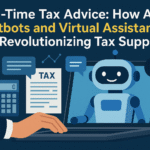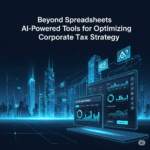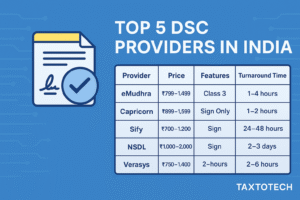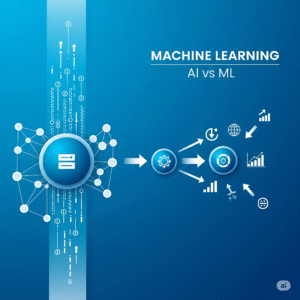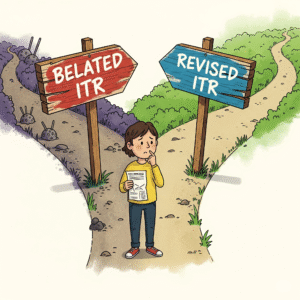For any business, the specter of a tax audit looms large. It conjures images of endless paperwork, grueling interrogations, and potentially significant financial penalties. Beyond the monetary cost, an audit consumes invaluable time and resources, diverting focus from core business operations. The reality is, tax authorities like the IRS are becoming increasingly sophisticated in their audit selection, moving beyond random checks to data-driven targeting. This means businesses need more than just accurate bookkeeping; they need proactive strategies to minimize their exposure.
Traditionally, businesses relied on human meticulousness, external auditors, and hoping for the best. However, as the volume and complexity of financial transactions grow, these methods are often insufficient. This is where AI analytics steps in, transforming the landscape of tax compliance. At Taxtotech, we believe that understanding how AI analytics strengthens business tax filings is no longer a luxury for large corporations but a vital tool for businesses of all sizes aiming for robust compliance and peace of mind. Let’s delve into how AI is revolutionizing audit preparedness and significantly reducing audit risk.
The Business Imperative: Understanding Tax Audit Triggers
To effectively mitigate audit risk, businesses first need to understand what typically triggers an audit. While random selection can occur, most audits are initiated due to specific red flags:
- Discrepancies in Reported Income: Mismatches between what you report and what third parties (like banks, payment processors, or clients reporting payments to you) report to the tax authorities.
- Unusual or Excessive Deductions: Deductions that are disproportionately high compared to industry averages or the business’s reported income. This often includes large travel, entertainment, or home office deductions.
- Significant Fluctuations Year-over-Year: Sudden, unexplained increases in deductions or decreases in income compared to previous years.
- High Cash Transactions: Businesses that deal heavily in cash may be scrutinized more closely due to the difficulty in tracking.
- Complex Financial Structures: Businesses with intricate ownership structures, international operations, or significant related-party transactions often face higher scrutiny.
- Reporting Net Losses Consistently: Repeatedly reporting losses, especially for businesses that have been operating for several years, can trigger an audit.
- Industry-Specific Red Flags: Certain industries have higher audit rates due to historical non-compliance issues or unique tax complexities.
- Incomplete or Inaccurate Records: Poor record-keeping, missing receipts, or disorganized financial statements make an audit much harder to defend.
The consequences of an audit can be severe: back taxes, interest, penalties, and extensive professional fees. More importantly, the disruption can derail business operations and damage a company’s reputation. This underscores the critical need for advanced tools like AI analytics in strengthening tax filings.
What is AI Analytics in the Context of Tax Filings?
AI analytics for tax filings goes far beyond standard accounting software’s data entry and basic reporting. It harnesses the power of Artificial Intelligence and Machine Learning (ML) to perform deep dives into your financial data, identifying patterns, anomalies, and potential risks that would be impossible for human review alone.
At its core, AI analytics involves:
- Pattern Recognition: AI algorithms are trained on vast datasets, including historical tax filings, audit results, industry benchmarks, and tax regulations, to recognize typical and atypical financial behaviors.
- Anomaly Detection: It identifies transactions, deductions, or reporting inconsistencies that deviate significantly from established norms or your own historical data. These anomalies are often indicators of potential errors or red flags for tax authorities.
- Predictive Modeling: Based on identified patterns and risk factors, AI can assess the “audit likelihood” of specific line items or your entire tax return, pinpointing areas where scrutiny is most probable.
- Continuous Learning: The more data it processes and the more interactions it has (e.g., with tax experts reviewing its findings), the smarter and more accurate the AI becomes at identifying risks and opportunities.
Essentially, AI analytics acts as a vigilant, non-stop internal auditor, proactively scanning your entire financial footprint to shore up your tax defenses before you file.
Key Ways AI Analytics Reduces Audit Risk
Leveraging AI analytics in your tax preparation provides a multi-layered defense against audit triggers:
- Automated Data Validation & Reconciliation:
- The Power: AI systems integrate directly with all your financial data sources – ERPs, banking, payroll, POS systems – to cross-reference and validate every transaction. It flags discrepancies between different records (e.g., bank statement vs. ledger entries, invoices vs. payments received) automatically.
- Audit Risk Reduction: Ensures data consistency and accuracy across all financial records, eliminating common errors that often spark audit inquiries. A clean, reconciled book is a strong defense.
- Anomaly Detection & Predictive Flagging:
- The Power: ML algorithms analyze your current and historical financial data against industry benchmarks and known audit triggers. They can identify unusual transaction volumes, disproportionate expenses, or patterns that signal a higher risk of audit scrutiny. For example, AI might flag unusually high “other business expenses” if it deviates from your historical trends or industry norms.
- Audit Risk Reduction: Proactively identifies “red flags” before filing, allowing you to investigate, correct, or gather robust documentation for potentially problematic areas.
- Comprehensive Deduction & Credit Validation:
- The Power: AI analytics doesn’t just identify potential deductions (as discussed in previous articles); it also validates their legitimacy and ensures proper documentation is in place. It can cross-reference expenses with relevant tax codes, assess if a deduction meets specific criteria, and even alert you if supporting documentation (like receipts for meals) is missing or insufficient.
- Audit Risk Reduction: Ensures that every deduction and credit claimed is legitimate and fully defensible with adequate documentation, preventing disallowances and penalties during an audit.
- Compliance Monitoring & Regulatory Alignment:
- The Power: AI tools can continuously monitor changes in tax laws, regulations, and reporting requirements (federal, state, and local). They can then automatically assess the impact of these changes on your current financial data and tax positions.
- Audit Risk Reduction: Keeps your tax filings aligned with the very latest compliance mandates, reducing the risk of audit due to outdated practices or missed regulatory updates.
- “Audit Likelihood” Scoring and Prioritization:
- The Power: Some advanced AI analytics platforms can assign a “risk score” to different aspects of your tax return or even the entire filing. This score is based on a multitude of factors, including the presence of red flags, industry trends, and compliance with specific rules.
- Audit Risk Reduction: Allows tax teams to prioritize their review efforts, focusing human attention on the areas with the highest perceived audit risk, thus optimizing resource allocation for audit defense.
- Automated Documentation & Audit Trail Generation:
- The Power: AI-powered systems can automatically compile and organize all supporting documentation for your tax filings, creating a comprehensive and easily navigable audit trail. This includes linking specific transactions to receipts, invoices, contracts, and relevant tax code references.
- Audit Risk Reduction: Provides an immediate, clear, and robust defense if an audit does occur, demonstrating transparency and meticulous record-keeping. This speed and organization can significantly shorten audit timelines and reduce potential liabilities.
AI Analytics vs. Traditional Methods for Audit Risk Reduction
| Aspect of Audit Risk Reduction | Traditional Methods (Limitations & Challenges) | AI Analytics (Solutions & Benefits) |
| Data Accuracy | Manual entry errors, reconciliation issues, fragmented data. | Automated validation, real-time reconciliation, consistent data across systems. |
| Red Flag Identification | Human oversight prone to missing subtle patterns, limited by data volume. | Anomaly detection, predictive flagging of audit triggers, continuous monitoring against benchmarks. |
| Deduction Validation | Manual review of documentation, risk of missing compliance details. | Automated verification of deduction legitimacy, checks for proper documentation, tax code alignment. |
| Regulatory Compliance | Manual tracking of law changes, delayed adaptation, potential for outdated practices. | Real-time regulatory monitoring, automated impact analysis, ensures adherence to latest laws. |
| Risk Prioritization | Intuitive, experience-based, no objective scoring of risk areas. | Algorithmic “audit likelihood” scoring, visual dashboards for high-risk areas. |
| Audit Preparedness | Manual document compilation, disorganized records, time-consuming. | Automated audit trail generation, linked documentation, immediate access to supporting data. |
Implementing AI Analytics for Audit Readiness: Best Practices
Integrating AI analytics effectively for reducing audit risk requires a strategic approach:
- Prioritize Data Quality: AI models are only as good as the data they’re fed. Invest in data cleansing, standardization, and a robust data governance framework from the outset.
- Seamless Integration: Choose AI analytics solutions that can seamlessly integrate with your existing ERP systems, accounting software, and other financial data sources to ensure a comprehensive view.
- Maintain Human Oversight: AI is a powerful tool, but it’s an assistant, not a replacement. Tax professionals must review AI-generated insights, validate findings, and apply judgment to complex or ambiguous situations.
- Continuous Learning & Feedback: The best AI analytics systems improve over time. Provide feedback to the system on its findings and actively use its insights to refine your processes.
- Phased Adoption: Start with a pilot program focusing on a specific high-risk area (e.g., expense categorization or intercompany transactions) to demonstrate value and refine your approach before a full rollout.
- Invest in Training: Ensure your tax and finance teams are trained not just on how to operate the software but also on how to interpret and act upon the AI’s analytical insights.
Beyond Risk Reduction: The Strategic Benefits of AI Analytics
While reducing audit risk is a primary benefit, AI analytics offers broader strategic advantages for businesses:
- Enhanced Financial Transparency: A cleaner, more accurate, and more accessible data set means better visibility into all aspects of your company’s financial health.
- Improved Strategic Decision-Making: With real-time insights into spending patterns, profitability by segment, and tax liabilities, businesses can make more informed decisions about resource allocation, investments, and operational changes.
- Resource Optimization: Automating data reconciliation and risk identification frees up your highly skilled finance and tax professionals to focus on higher-value activities like strategic tax planning, forecasting, and business advisory.
- Stronger Corporate Governance: Robust AI-powered tax compliance demonstrates a commitment to ethical and accurate financial reporting, enhancing investor confidence and corporate reputation.
- Identification of New Opportunities: Beyond just finding errors, AI can sometimes identify patterns that suggest new tax planning opportunities or efficiencies that might have been overlooked.
Broader Business Benefits from AI Tax Analytics
| Benefit Area | How AI Tax Analytics Contributes | Impact on Business |
| Financial Transparency | Unified, accurate, real-time view of all financial data. | Better understanding of financial health, improved internal controls. |
| Decision-Making | Data-driven insights, predictive analytics for strategic choices. | More informed budgeting, investment decisions, and operational adjustments. |
| Resource Optimization | Automation of tedious tasks, allowing staff to focus on strategic work. | Higher productivity for tax/finance teams, reduced need for manual headcount. |
| Corporate Governance | Demonstrates proactive compliance and ethical financial practices. | Enhanced investor confidence, stronger brand reputation, better regulatory standing. |
| Cost Savings | Reduced errors, fewer penalties, optimized tax positions, lower audit fees. | Direct bottom-line improvements, more efficient use of capital. |
| Time Savings | Accelerated data processing, faster reconciliation and reporting. | Free up significant time for strategic planning and business development. |
Conclusion: Fortifying Your Business Against Audit with AI
The days of simply “hoping for the best” when it comes to tax audits are behind us. In an era of increasingly sophisticated tax authorities and complex regulations, AI analytics has become an indispensable ally for businesses committed to reducing audit risk. By leveraging AI’s power to validate data, detect anomalies, verify deductions, and ensure continuous compliance, companies can transform their tax filings from a potential liability into a fortress of accuracy and defensibility.
At Taxtotech, we are dedicated to helping businesses like yours navigate the evolving landscape of tax and technology. Embracing how AI analytics strengthens business tax filings is not just about avoiding penalties; it’s about building a foundation of financial integrity, gaining strategic insights, and empowering your team to focus on growth. Don’t leave your business vulnerable; fortify your tax position with the intelligence of AI.
We’d love to hear from our Taxtotech Readers!
- What’s your biggest concern when it comes to tax audits for your business?
- Have you used any form of analytics or AI to prepare your tax filings? What was your experience?
- How do you think AI could further transform audit defense in the next few years?
Share your insights and questions in the comments below! Your experiences help to enrich our community’s understanding of this critical topic. And for more cutting-edge insights on how technology is revolutionizing finance, remember to visit https://taxtotech.com. Let’s build a more secure financial future, together!




